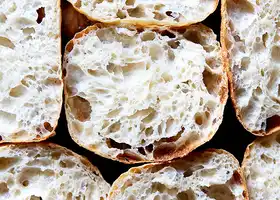Download Stashcook Now. Get the best meal planning app for your family.
Simple Sourdough Ciabatta Bread Recipe

Notes: You need an active sourdough starter. You can build a starter from scratch in just about 1 week. But I am a huge proponent of buying a starter. Here are two sources: King Arthur Flour Breadtopia As always, I highly recommend investing in a digital scale before beginning any bread baking adventure. Flour: I have had success using all-purpose flour, but if you can get your hands on bread flour, that is ideal, especially if you live in Canada or abroad. Moreover, if you live in Canada or abroad, you may need to reduce the water amount. Consider holding back some of the water during the mixing process to ensure you don't end up with a soupy mess. Straight-Sided Vessel: The vessel I use in this recipe, similar to this one, is 8 cups. Most grocery stores carry storage vessels similarly sized. Using a straight-sided vessel for the bulk fermentation will help prevent over-fermentation because it allows you to see when the dough has truly increased by 75% (or slightly more or less) in volume.
Ingredients
Method
Email:
hello@stashcook.com© Copyright 2025 Stashbox Ltd. All rights reserved.